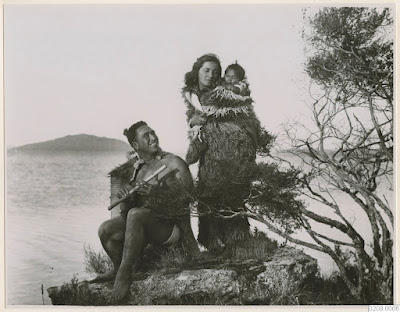Rotorua has the honour of being the location of the first feature film shot in New Zealand.
George Tarr's Hinemoa, which was filmed in eight days in Rotorua, premiered at Auckland's Lyric Theatre on 17 August 1914. (Mita, 1992).
 |
| Advertisement for screening of Hinemoa following premiere. Auckland Star (1914, August 14), p. 8. Papers Past. |
Tarr had borrowed 50 pounds from Auckland Chamber of Commerce president Edward Anderson and with cameraman Charles Newman had travelled to Rotorua. Tarr had originally intended on producing a film based on Māori life as depicted in the travelling show The Maori. At Home! At Play! At War!, by Reverend Frederick Bennett's Rotorua Māori Mission Choir and Entertainers. But the prospect of war with Germany prevented the expensive project from going ahead. Anderson had offered to fund a similar smaller project. Tarr went to the library. He said 'I read Hinemoa backward and forwards and forwards and backwards and I wrote a scenario'. He meet with Anderson that same day and by the following evening he was in Rotorua (Yarwood, 2021, p. 128).
Hera Tawhai (Sarah Rogers) and her husband Rua played the main roles of Hinemoa and Tūtānekai. They had been playing the roles in a Māori concert in Rotorua. Tarr put the film together with minimal editing. In an interview recorded when he was 81, Tarr said 'I did it as much as possible with the scenes following each other...As a matter of fact, our cuttings were nil, practically' (Martin & Edwards, 1997, p. 23).
Sadly the nitrate film stock has long since disintegrated and the film is lost. All that remains are a few productions stills, daybills, and radio interviews (Martin & Edwards, 1997).
 |
| Hinemoa (Dir. George Tarr, 1914). Hera Tawhai Rogers as Hinemoa. Image reproduced with permission from the family. |
In 1962 Rogers did a radio interview in which she recalled her role, costumes and adventures shooting on location. You can listen to this interview here.
Tarr's was the second film based on the legend of Hinemoa and Tūtānekai. The first was a short film directed by French American-based filmmaker Gaston Méliès, who was the older brother of famous filmmaker Georges Méliès. In 1913 he shot three short films in Rotorua - How Chief Te Ponga Won His Bride, Hinemoa, and Love by a Māori Chieftess, as well as five scenic tourist films. Méliès would be one of the first directors to understand the ease in which Māori actors took to the camera (Harvey, 2005).
Méliès brought 17 members of his filmmaking company from America to New Zealand. He engaged James Cowan as a cultural advisor. He described Cowan as an 'authority on Māori legend and custom' and as a 'general advisor and interpreter' (Fox, Grant, Radner, 2011, p. 18). It is also believed that Reverend Bennett was also involved in Méliès' production as he credits a Pastor Bennett (Martin & Edwards, 1997). |
| Gaston Méliès at Whakarewarewa, 1912. Image reproduced with permission of Tūhourangi Tribal Authority |
A third adaption of the Hinemoa and Tūtānekai legend, The Romance of Hine-Moa was directed by Danish director Gustav Pauli for British film production company Sphere Films and released in 1927 (Bythe, 1994).
Maata Hurihanganui (Martha
Wickliffe) was cast Hinemoa. Minister of Native Affairs Sir James Carroll’s son
Wiki was cast as Tūtānekai. Wickliffe told the Daily
Post aged 75 that 'I just couldn’t
act with him.' So Martha’s cousin Matt Hona (Akuhato) was cast.
Only the first reel now survives. It was found in 1981 by London barrister Mr J Samuels who lived in a house once owned by Pauli and loaned to the New Zealand High Commission and later transferred to the New Zealand Film Archive.
Wickliffe said in an interview in 1981 that she was paid a pound a day. 'A lot of money in those days. I thought it a great honour to play Hinemoa. The film was very well received overseas. It blended a love story into the scenic beauty of New Zealand. Many overseas viewers found it a wonderful experience to see another country' ("Star of Hinemoa", 1981, p. 1)
Rotorua was an early popular film location largely due to its scenery, but also because the Te Arawa people were active in the tourism industry as guides and performers, and these skills adapted well to film acting.
Other notable films shot in Rotorua include:
- A Māori Maid's Love (1916, Dir. Raymond Langford)
- The Mutiny of the Bounty (1916, Dir. Raymond Langford)
- The Birth of New Zealand (1922, Dir. Harrington Reynolds)
- The Adventures of Algy (1925, Dir. Beaumont Smith)
- Rewi's Last Stand (1925, Dir. Rudall Hayward)
- Under the Southern Cross, also known as The Devil's Pit or Taranga (1929, Dir. Lew Collins)
References:
Blythe, M. (1994). Naming the other: images of Maori in New Zealand film and television. The Scarecrow Press.
Callanan, V. (2011). Gaston Méliès. In D. Pivac, F. Stark, & L. McDonald) New Zealand Film: an illustrated history (pp. 45). Te Papa Press.
Dennis, J. (1992). A time line. In J. Dennis & J. Bieringa (Eds.), Film in Aotearoa New Zealand (pp. 183-219). Victoria University Press.
Fox, A., Grant, B. K., & Radner, H. (2011). Introduction: the historical film in New Zealand cinema. In F. Fox, B. K. Grant, H. Radner (Eds.), New Zealand cinema: interpreting the past. Intellect.
Harvey, B, (2005). White cloud, silver screen. Exisle Pub.
Martin, H. & Edwards, S. (1997). New Zealand Film, 1912-1916. Oxford University Press.
Mita, M. (1992). The soul of the image. In J. Dennis & J. Bieringa (Eds.), Film in Aotearoa New Zealand (pp. 37-54). Victoria University Press.
Star of Hinemoa film still has charm, beauty. (1981, October 1). The Daily Post, 1.
Yarwood, V. (2021, July-August). How to make a film in eight days. New Zealand Geographic, 170, 128.
